| Main page » Polish armour » armoured trains » Nr. 55 – Polish artillery – Steel Panthers – what's new |  |
||
| © Michal Derela, 2002 | Updated: 9. 8. 2024 | ||
| Main page » Polish armour » armoured trains » Nr. 55 – Polish artillery – Steel Panthers – what's new |  |
||
| © Michal Derela, 2002 | Updated: 9. 8. 2024 | ||
Early history – Combat use in 1939 – Description
The second Polish light armoured train of World War II used in 1939 was Nr. 55, former "Bartosz Głowacki". For many years this unit was the most mysterious of Polish regular armoured trains from 1939, since there were no photographs depicting its look available in popular sources. Pre-war photographs were obscure, while only after a fall of communism photographs of the captured train were revealed from Soviet archives. That is why sometimes it was erroneously regarded as the train of the same Austro-Hungarian type as the other light armoured train, Nr. 15 "Śmierć". Coincidentally, both trains had the same Cracow origin, although at the beginning they had completely different rolling stock than that, for which they are known from 1939 combat. With new research, our knowledge of this train is almost complete by now.
In 2012 this article underwent major enhancement, thanks to help of Krzysztof Margasiński.
Note: links without an underline lead to relevant Wikipedia articles.
The original armoured train "Bartosz Głowacki" was created in August 1920 in Kraków (Cracow), during Polish-Soviet war. At that time, the Red Army had repelled the Polish and allied Ukrainian forces from eastern Ukraine and was advancing towards Lviv and Warsaw. In July 1920, the Polish headquarters ordered a haste construction of six new armoured trains, to compensate for units lost during withdrawal fights. The Armoured Trains' Construction Management (Kierownictwo Budowy Pociągów Pancernych – KBPP) in Kraków raised two trains then: the "Śmierć" and the "Bartosz Głowacki". The later was assigned a number 20 (P.P. 20 – Pociąg pancerny - armoured train nr 20), after the lost train "Generał Dowbor".
Bartosz Głowacki (born Wojciech Bartos, ~1758-1794) was a peasant, who gained the glory leading a scythemen assault on Russian cannons in the battle of Racławice during Kosciuszko Insurrection in 1794. For his valour, Chief Tadeusz Kościuszko promoted him to officer and honoured with a noble name "Głowacki". An approximate pronunciation in English is: BAR-tosh Gwo-VAT-ski.
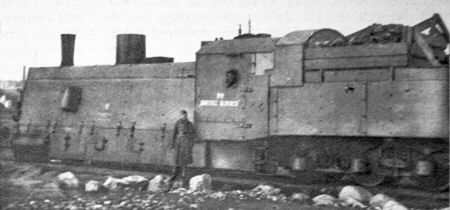 |
| A Prussian locomotive G71 4460 Breslau, armoured in Warsaw, used in the "Bartosz Głowacki" in 1920 (probably up to 1924). |
 |
| "Bartosz Głowacki" in 1920 – a commander Lt. Stanisław Pigoń with officers, Lt. Tadeusz Strumiłło and Lt. Olgierd Grzymała-Grzymałowski. |
The train was built of a stock of Prussian origin, armoured and armed in Poland. Originally it consisted of two covered artillery wagons, each with a 76 mm gun, an open artillery wagon and several assault (infantry) wagons. The armament was supplemented by 10 machine guns (6 Bergmann LMG, the rest presumably Maxim heavy machine guns) and 70 rifles. Covered artillery wagons, converted from small open freight wagons, were armoured with steel plates and fitted with a central gun turret on a roof, with all-around arc of fire. The guns used were Russian M.1902 Putilov 76.2 mm. The third artillery wagon was probably a flatcar with a revolving shielded gun mounting. Assault wagons were wooden freight box cars with loop-holes for machine guns and rifles and with observation or machine gun turrets on a roof. Typically such wagons were protected with concrete or double walls with sand layer. The train included a wagon with a 60 cm Austrian searchlight M.16, armoured in Kraków with steel sheet plating. The train had a Prussian locomotive G71 class (number 4460 Breslau), fully armoured in Poland. The crew in September 1920 was 8 officers, 37 NCO and 97 soldiers. Its first commander was Lt. Stanisław Pigoń (later an acknowledged philologist and professor, rector of university in Vilnius), and from October 1920, Lt. Marian Truskolaski.
The "Bartosz Głowacki" was completed in Cracow and blessed there during a ceremony on 30 August 1920 (the press commented, that: the new ironclad looks impressive). Then it left for Warsaw, and on 2 September it was moved to a front, assigned to the armoured trains' unit at a disposal of the 15th Infantry Division of the 4th Army (along with armoured train "Wilk" – Wolf). From 10 September "Bartosz Głowacki" operated on Czeremcha – Brest line. During fights, two of its guns got damaged on 18 and 19 September, and the third gun blew up on 20 September, killing one crewmen and injuring four. The trains however helped to capture Svislach. After that, the train temporarily used borrowed field guns on flatcars. "Bartosz Głowacki" next took part in a battle of the Niemen River, supporting attack of Gen. Jung's group on Volkovysk (captured on 23 September). The train distinguished itself on 23 September, helping the 62nd Infantry Regiment to capture a village Polonka near Svislach. On 24/25 September at night, the trains covered Polish withdrawal from Volkovysk. At that time, the train had six wagons with two field guns and ten machine guns[4]. After a truce, from November 1920 the train was under command of the 2nd Army and until summer of 1921 stationed in Lida.
After Polish-Soviet war, "Bartosz Głowacki" was assigned for a further service, among 12 trains left. Its rolling stock was however soon replaced with more combatworthy one. According to A. Jońca, by late 1921 its both central turret artillery wagons were passed to the train Nr. 18 "Huragan"”[7]. Its improvised infantry wagons returned to freight wagons' role.
Both original artillery wagons of "Głowacki", with central turrets, survived longer, than its newer stock. They were built upon small Prussian open freight wagons Omku series, German A6 type or earlier Prussian IId1 type. According to K. Margasiński, they had numbers Omku 66 293 and 103 250, according to A. Jońca: 103 227 and 126 265. After a demobilization of Polish armoured trains in 1923, one wagon was assigned "on paper" to the train Nr. 4 "Śmierć" (renumbered to 398 624), and the second to the train Nr. 2 "Generał Sosnkowski" (renumbered as 398 625)[7]. During a final reorganization in 1930 they both were withdrawn to a reserve, although they underwent a modernization then (cutting off corners to fit four MG ports, removing side doors, fitting standard 75 mm wz.02/26 cannons). They were used in combat in 1939 in a Polish improvised training armoured train of the 2nd Armoured Train Unit, destroyed after fighting with German armoured units on 10 September in a railway jam near Jarosław. After their capture by the Germans, these wagons were used in German armoured trains: Panzerzug 21 and Panzerzug 22, which remained active until a closing period of World War II (one of them was rearmed with a quadruple 20 mm Flakvierling AA gun).
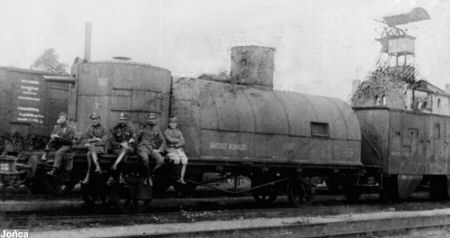 |
| "Bartosz Głowacki", around 1922-1923, with a new Warsaw type artillery wagon from PP.4 "Hallerczyk", with 76 mm M1914 Lender gun, and a new assault wagon (probably from PP.3 "Lis-Kula"), possibly during anti-strike action in Upper Silesia. |
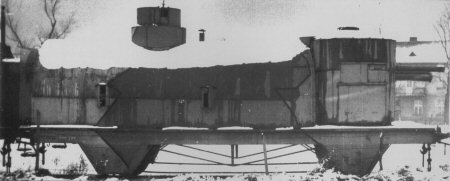 |
| Warsaw type artillery wagon nr. 630 728 of the "Bartosz Głowacki" after a modernization in early 1930s. Note a camouflage from outbreak of 1920s/1930s, with jagged thick division lines (it is better visible on a drawing further on the page). |
Moving back in time: in late 1919 Polish Army intended to build several new broad-gauge armoured trains to use on Russian tracks 1524 mm gauge (5ft, instead of a standard gauge 1435 mm used in mainland Europe). They were meant to support Polish units advancing to the east, without need of converting track to standard gauge. At that time, Poland operated some broad-gauge trains, which had been captured or converted from standard-gauge trains. The new trains were to be built using captured Soviet broad-gauge flatcars, gathered in this purpose at Gerlach and Pulst factory in Warsaw. A design was developed by the Armoured Trains' Construction Management (KBPP) in Warsaw. Their distinguishing feature was a construction of rounded narrow armour stripes, giving them rounded, "half-barrel" shape in cross-section. They were fit to be converted from broad gauge to standard gauge and back.
Due to war events (Polish withdrawal in summer of 1920), the need of broad-gauge trains disappeared. Some wagons were however completed and used to reconstruct or reinforce existing armoured trains. Yet in spring 1920, such artillery wagons were used in trains: "Piłsudczyk" and "Lis-Kula", and in summer 1920 in "Hallerczyk", "Wilk", and "Reduta Ordona". Assault wagons were used, in different periods, in trains: "Paderewski", "Generał Sosnkowski", "Śmiały" and "Poznańczyk" (in latter two – until 1939) (the list is not comprehensive). The "Bartosz Głowacki" ultimately received two Warsaw-type artillery wagons and one assault wagon. At least one such artillery wagon from disbanded "Hallerczyk" was given to the "Głowacki" yet in 1921, along with steel infantry wagons of other type from other trains. Other stock used in that period is not known so far – possibly it retained also its old artillery wagons and G71 locomotive for some time.
In the winter of 1923/24, "Bartosz Głowacki" was demobilized and stored, along with most of Polish armoured trains. Apparently it has not been brought back from reserve to active service before World War II. In 1925, still in reserve, it was given a new number P.P. 10 and assigned to the 5th Armoured Train Unit in Kraków, along with P.P. 9 "Pierwszy Marszałek". In case of a mobilization, the "Bartosz Głowacki" was supposed to be equipped with one Warsaw type single-turret artillery wagon no. 673 025 and one twin-turret ex-Soviet Krasnoye Sormovo type artillery wagon no. 460 022 (two such wagons were used in the "Pierwszy Marszałek" before and after that)[7]. A locomotive was to be Polish-armoured Austrian 73.376 locomotive (earlier used in trains: P.P. 18 "Odsiecz II" and P.P. 6 "Generał Iwaszkiewicz", later Polish Railways Tp15-177)[7]. Armament was to be three 76 mm guns and machine guns, while the train had no assault wagon assigned. At last, by January 1930, there was established a final composition of Polish armoured trains, and "Bartosz Głowacki" was equipped with two single-turret artillery wagons and one assault wagon, all of Warsaw type. It was also given a standard Ti3-10 armoured locomotive.
By early 1930s the train's stock underwent a modernization. Its armament was standardized (75 mm wz. 02/26 cannons and 7.92 mm wz. 08 Maxim MGs), it received radio and signal equipment and anti-aircraft machine guns in artillery wagons. It was assigned to the 2st Armoured Train Unit (Dywizjon Pociągów Pancernych) in Niepołomice, near Kraków.
On 23 August 1939, former "Bartosz Glowacki" started its mobilization as pociąg pancerny nr 55 - armoured train nr. 55 (names were not used officially anymore).
Armoured train nr. 55 (former "Bartosz Glowacki") was commanded by Cpt. Andrzej Podgórski.
On 27 August 1939 the train was moved from Kraków to Tłuszcz, where it remained until 3 September. After German attack on Poland, it underwent an air raid on this station on 2 September, without losses. Then it was assigned to the Reserve Army "Prusy", but during next week, between 4 and 12 September, it was moved from one place to another in a vicinity of Warsaw (September 4th: Koluszki, 7th: Skierniewice, 8th: Warsaw, 10th: Mińsk Mazowiecki and Siedlce, 11th: Łuków, 12th: Międzyrzec), along with the armoured train Nr. 53 ("Śmiały"). The trains had no combat orders at that time, and only on 8 September they patrolled a track Skierniewice – Żyrardów. It was planned to use the trains on 5 September at Piotrków direction, where a combat took place, but the track damage and jams prevented it. The trains were remaining without a contact with the enemy in that period, apart from several air raids against railway infrastructure, which did not do harm to armoured stock (on 5 September however, an auxiliary section of the train Nr. 53 was bombed at Koluszki station, and both trains had to share Nr. 55 train's auxiliary section afterwards). Their crews helped to fix damages to the track. On 10 September the trains had to overcome heavy railway jam between Mińsk Mazowiecki and Siedlce, removing bombed wagons and even building detours. On 11 September the crew of "Bartosz Głowacki" found an abandoned 40 mm Bofors wz. 36 anti-aircraft gun in Łuków, which, seated upon a flatcar, remarkably strengthened the train's defence.
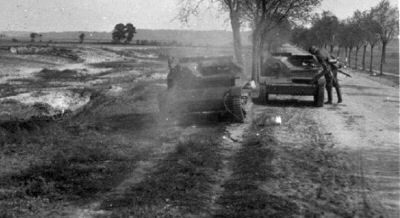 |
| Two TKS tankettes destroyed at Zhabinka. The one on a roadside is burnt and has a pierced right front gear hatch, the other one (later hauled away) has three holes in a lower front plate. |
 |
Finally, both trains were moved to Brześć fortress (now: Brest, Belarus). The train Nr. 55 first came into action on 14 September near Zhabinka railway station, east of Brześć, where a reconnaissance unit of the 3rd Panzer Division was reported. Four TKS tankettes of the train's armoured draisines were dismounted and sent southwards of the line, towards a bridge on the Mukhavets, but three of them were hit by the German armoured car platoon, standing on the bridge, and destroyed (luckily, without crew losses). An attempt to use the train's assault platoon failed in the German fire. Only the train's artillery made the enemy unit withdraw.
| "In a pursuit after two enemy tanks, a section entered Zhabinka. ...There, on a railway crossing, which they had crossed an hour ago without problems, stood an armoured train. From last wagon, Polish gunners aimed guns at German vehicles. The commander quickly estimated a situation: "run, Heini, and back!" – he cried as loud as he could. Only top speed could save everybody's lives. Both cars withdrew on reverse gear, too quickly for the train's gunners. The first round flew over heads and landed somewhere in a village..." | German account by Corporal Pretschner, from a reconnaissance platoon.[10] |
Soon after that, the train, standing on a crossing, halted and made retreat a column of the division, approaching on a road from the north from Kamenets, preceded by a motorcycle company. Several cars were destroyed in a process. Taking cover behind a hill, a group of tanks of the 5th Regiment made an attempt to cut the train's way back to Brest, but the train's artillery foiled their movement. Next, the train was shelled by a battery of the 75th Artillery Regiment, and after about 45-minute duel, it withdrew to Brest. One of the train's Renault tank draisines was damaged and left, apparently during an attempt to use it on a ground (photos in a section on draisines below). In this combat, the train successfully managed to delay a movement of elements of the German armoured division. Some German sources credited own units with a destruction of an armoured train in that skirmish, which was obviously false.
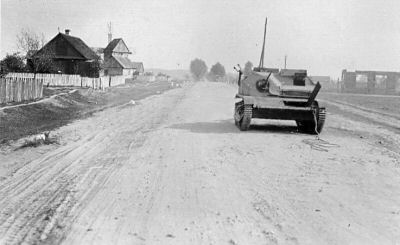 | 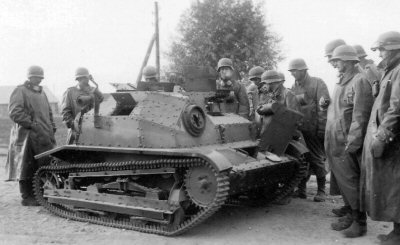 |
| The next TKS tankette destroyed in Zhabinka. Other photos show, that it had fire marks, a pierced lower front plate on the right and a damaged muffler, possibly also a hole in a right side under a window. Visible are extenders on chassis frame, typical for tankettes used as draisines. This tankette was later pushed aside from a road to a field, turned on its roof, and again put on tracks. | |
Since German units captured a part of Brest and its main railway station in the afternoon that day, armoured trains Nos. 55 and 53 were ordered to withdraw south (crews had to load coal manually first, due to infrastructure damages). On 15 September they reached Kovel, taking an occasion for locomotive maintenance. On the next day the trains were ordered to go towards Lutsk. On 17 September, near Kivertsi, commanders learnt about Soviet invasion, and chose to go to Lwów (now Lviv, Ukraine), threatened by the German encirclement. On the next day the trains broke through to Lwów, repairing a track on the way, removing wrecked wagons, and firing at German positions near the city on passing. The train Nr. 55 was assigned to north-western defence sector, basing at Podzamcze station, while the train Nr. 53 was assigned to south-eastern sector. On 19 September the train Nr. 55 supported a battalion of the 35th Infantry Division (Reserve) in a sortie from Lwów to Holosko and no. 374 hill, in order to get in contact with an approaching Gen. Sosnkowski's army. In that action, the train got under fire of enemy artillery of the 1st Mountain Division, and suffered some damage. Wagons were damaged and a main steam pipe was pierced in the locomotive, though casualties were not high (two killed and several injuried). The train was pulled out back with an ordinary locomotive, but was incapable of further fighting. According to some sources however, it was ready to action on 20 September in the morning[6]. It seems plausible, considering good condition of armoured wagons after their capture, nevertheless there is no information on its further usage in combat. On 22 September 1939, Lwów surrendered to Soviet soldiers, which had invaded Poland on 17 September, and have just approached the city in accordance with German–Soviet agreement on partition of Poland. Both armoured trains, Nos. 55 and 53 were captured by the Soviets in the city.
This was not the end of the train's life, though. The Soviets repaired the train, and put into service as an armoured train (BP or bepo – bronyepoyezd) of the 58th NKVD Regiment (the NKVD armed forces were used as border security guards). It probably consisted of the armoured locomotive and two artillery wagons only according to Soviet regulations (not counting flatcars). According to new information, it was damaged and disabled in a combat with German tanks on Baranavichy – Pogorelcy line (Moscow – Brest Railway) in summer of 1941. Its artillery wagons were not impressed into German service. A former assault wagon of the "Bartosz Glowacki" was captured in 1941 in Lviv, and used until 1944 in the German train Panzerzug 10a, created of ex-Soviet (former Polish) stock. The locomotive Ti3-10 was also reported in German service, stripped of armour.
Main source for 1939 service: [2]
| Drawings: A. Jońca | |||||
 | |||||
| flatcar | artillery wagon | armoured locomotive | assault wagon | artillery wagon | flatcar |
 | |||
| TK-R-TK unit | draisine TK | draisine R | |
An armoured train, as a military unit, consisted of: an armoured section (the armoured train in a strict meaning), a platoon of armoured draisines and an unarmoured administrative or auxiliary section. The armoured section and armoured draisines were the combat section of the armoured train, while the administrative section was supporting the operation of the combat section in respect of logistics and accommodation, and did not take part in combat, staying at the rear.
From around 1936, combat rolling stock was painted in a standard three-color camouflage of Polish vehicles, consisting of irregular dark brown and olive green patches, airbrushed upon a greyish sand basic color. The patches were oblong, mainly horizontal. Earlier – from early 1930s, there was used a scheme of three unknown colours (probably dark yellow, olive green and light blue gray, like in armoured vehicles, or light grey, green and brown), separated with thick jagged black lines.
The train no. 55 was a light armoured train, so the crew of armoured section can be estimated at about 90 men – the whole armoured train's crew was probably up to 140-150.
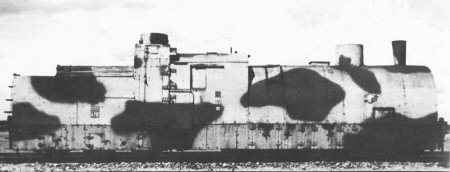 |
| Ti3-10 armoured locomotive of Nr. 55 armoured train soon after its capture by Soviets (green patches are not contrasting). |
A standard locomotive of Polish armoured trains in 1930s was the steam locomotive Ti3 class (former Prussian G53 class), armoured in Poland. The locomotive used in "Bartosz Głowacki" since 1930 was Ti3-10 (ex- G53-4015 Posen), built in 1904 by BMAG, number 3372. It was connected with a three-axle tender 12C1 no. 478. After being captured by the Soviets, it was given a number ZhBO-020 (ЖБО-020). This locomotive was later found in German service with a number 54 657 (captured in the USSR and stripped of armour).
Upon a tender, there was a commander's turret, equipped with a short-range radio RKB/C to contact draisines, and an intercom to contact wagons. It also had some optical and sonic means of internal communication (color lights, bells and horns). Maximum speed of a locomotive with armoured wagons was about 45 km/h (28 mph).
Two artillery wagons of Nr. 55 armoured train were of the same type, built in Poland upon ex-Soviet two-axle 18-ton flatcars, according to KBPP Warsaw design. From 1930s they carried numbers 630 728 and 630 729. One of wagons was initially used in train PP.4 "Hallerczyk".
In 1939, each wagon was armed with one 75 mm wz.02/26 field gun (modified Russian 3in Putilov gun) in a cylindrical turret at the end, rotating at about 320°. Initially, in 1920s they had Russian 76.2 mm wz.02 Putilov guns or 76.2 mm wz.14 Lender guns or other guns of similar caliber. Other armament consisted initially of two machine guns in the sides and possibly two additional ones in an artillery turret and one MG in a high turret (early drawing of the wagon nr 02006 of "Piłsudczyk"). By early 1930s, wagons were modified, and since then they were armed with four 7.92 mm wz.08 Maxim (MG 08) machine guns in standard Polish drum mountings, two on each side. There was also added an anti-aircraft MG of the same type in a new roof turret, with a maximum elevation 90°. The ammunition carried in a wagon was presumably some 100-120 artillery rounds and some 3,750 rounds per each MG (in 250-round belts), like in other Polish wagons.
The wagon was built of rounded steel strips. Its thickness was up to 20 mm, but it was probably made of boiler steel, not armour steel. Sides were probably covered with oak planks from an inside, like in other Polish wagons. The wagon had doors in end wall only, which enabled passing between wagons, with folding side shields. During the modernization they were fitted with partial armoured skirts, protecting sides of a floor and wheels only. Among internal equipment were ammunition trunks, rifle racks... and 15-litre coffee canister. A crew of the wagon was probably about 17-20 men (by comparison with twin turret wagons). Length was about 11.6 m
According to J. Magnuski, "Bartosz Głowacki" in the interwar period had three artillery wagons and an assault wagon of Warsaw type, numbers: 630726 to 630729, including two wagons armed with 75 mm guns and one wagon rearmed with 100 mm wz.14/19A howitzer[1][8]. Recently revealed photos however confirmed, that former "Bartosz Głowacki", captured by the Soviets in 1939, had only two artillery wagons, both armed with 75 mm guns – which was also a version present in most publications. Photographs also confirm, that the howitzer-armed Warsaw type wagon no. 630 727 went to war with the improvised training train of the 2nd Armoured Train Unit, and was destroyed after the train's last fight near Jarosław. It is not known, why a plan to replace one of cannon-armed wagons with a howitzer-armed one, like in the train Nr. 15, was abandoned. It can also be assessed, that it was worth bringing the armament of the two light armoured trains to the standard of Polish trains with four guns and equipping them with four single-turret wagons, using reserve wagons, including original small wagons of the "Głowacki". However, there is no information that such an option was even considered, and instead it was apparently decided to standardize the number of two artillery wagons per a train, creating two weaker trains.
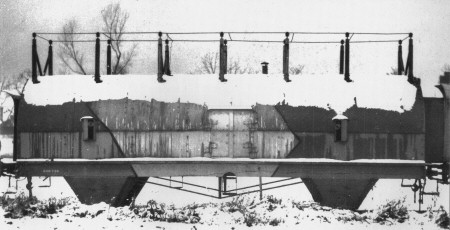 |
| Assault wagon in a camouflage from early 1930s. |
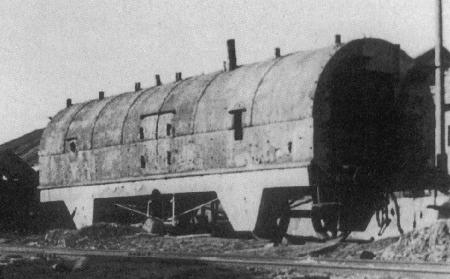 |
| Assault wagon from armoured train Nr. 55 in German service. |
An assault wagon in Polish nomenclature (wagon szturmowy) was intended for a transportation of an assault platoon. The origin of the wagon no. 630 726 of the "Bartosz Głowacki" was the same, as of artillery wagons (built in Warsaw upon ex-Soviet flatcar). It also had the same armour and design, lacking only an artillery turret. A. Przeczek put a hypothesis, that this peculiar wagon was even converted from an artillery wagon. The wagon had a two-leaf door in each side, and also doors in both end walls, protected with folding side shields with a rounded upper edge. Some of assault wagons also had hatches in a bottom. The wagon was armed with four 7.92 mm wz. 08 MG's in drum mountings in sides. The ammunition was 3,750 rounds per MG. The assault platoon consisted of 32 men (1 officer, 7 NCO, 24 soldiers, with 2 LMGs). A total wagon's crew was about 40 (with signalmen and stretcher-bearers).
In 1930s the assault wagon was equipped with a long-range radio RKD/P, placed in a separate radio cab in the middle of the wagon. The radio had maximum range 50–80 km with telegraphy (probably well below 20 km with voice transmission). The wagon was also fitted with a power generator, batteries and a large clothes line aerial on the roof with 7 masts in two rows. There was a heating stove inside (a chimney is visible on photographs).
A photograph on the right depicts the assault wagon from the armoured train Nr. 55, captured by the Germans in 1941 in Lviv and used next in armoured train Panzerzug 10a. Probably it was taken in 1944, after a destruction of the Panzerzug 10. In 1939 similar wagons were also used in trains: Nr. 53 "Śmiały" and Nr. 12 ("Poznańczyk"), but they differed in a bottom armour skirt (in "Głowacki" – cut off, only the wheels had trapezoid covers, in "Śmiały" – full skirt, in "Poznańczyk" – partially cut-off, and 6 rows of masts). Moreover, this wagon differs from others by centrally placed doors on one side (as a standard they were offset) and lack of armoured shields with visors in the armour. It is hence probable, that it was converted from a surplus artillery wagon.
The wagon's length was 11.6 m, width: 3.15 m, height (without aerial masts): 4.7 m, axle track: 6.1 m, axle pressure up to 14 t.
On both ends of the armoured train, there were two flatcars. Their primary function was to protect the armoured train against mines or a derailment. There was an observer with a central brake gauge on the flatcar. They were also adapted to carry engineering materials (tools, rails and sleepers, logs, explosives etc.) and also bicycles and motorcycles (part of it was carried on the auxiliary train's flatcars). As it was described above, during the campaign the train took 40 mm wz.36 Bofors AA gun onto one of flatcars, or additional one.
The standard flatcar series Pdkz (also known as Pdks) of C VIII type was two-axle. Its weight was about 10 t, load capacity – 17.5 t, frame length – 13 m, wheelbase – 8 m. Special flatcars for armoured trains were modified by fitting boxes for tools and small parts underneath, but there were not enough of them, and Nr. 55 armoured train had two ordinary flatcars.
Each armoured train, mobilized in 1939, had a platoon of armoured draisines (scout rail vehicles). Train Nr. 55 had a standard armoured draisines platoon, consisting of:
- two R type armoured draisines (Renault FT tanks on rail chassis)
- four TKS type armoured draisines (TKS tankettes on rail runners)
Draisines usually acted in two units, consisting of: one R and two TK draisines. All the tanks could be easily detached from their rail chassis' and then used for ground reconnaissance tasks. The fifth TKS tankette was in reserve. See the details on armoured draisines page.
Each armoured train, considered as a military unit, also included an unarmoured administrative or auxiliary section. The auxiliary section accompanied the combat section in operational movements and provided it with an accommodation and logistics support. It was manned by a platoon consisting of 1 officer, 21 NCOs and 26 soldiers. The length of the auxiliary section of the train was about 250 m (820 ft).
The auxiliary train consisted of: an ordinary locomotive, coaches for officers (2), box wagons for NCOs (2) and soldiers (8), an orderly wagon, ammunition wagons (2), a fuel store wagon, a technical store wagon, an ambulance wagon, a kitchen wagon, a workshop wagon, an open coal wagon, a water tanker and flatcars (5) – some 27 wagons in all[2]. According to other sources there were only three flatcars, but also a non-regulation food store wagon and sometimes guard wagon. The coaches were three-axle Dy series, the wagons were by default two-axle adapted boxcars Kd series.
The auxiliary train also should have two wz. 34 half-tracked trucks, one truck and four heavy motorcycles with sidecars CWS M-111 – carried upon three flatcars, although actual composition differed and might have contained other cars, like Polski FIAT 508/III field cars and pick-ups. Typical Polish truck was 2.5t Polski FIAT 621L (4x2). Wz. 34 half-tracks were in the repair patrol, and they could be equipped with a rail-riding device, although they were rather rare.
All comments, corrections and additional information or pictures are welcome
Update history:
Main page – Polish armour – Polish artillery – Steel Panthers – Contact
You can mail me with question or comments – corrections or photographs are welcome
All photos and pictures remain the property of their owners. They are published in non-commercial educational and research purpose.
Text copyright to Michal Derela, © 2000-2024